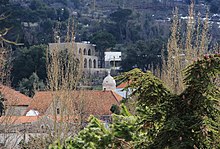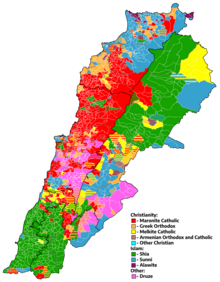Religion in Lebanon

Lebanese people, including the diaspora, are mostly Christians.[6][7] It is estimated that a large proportion of its population are refugees, accounting to approximately 2 million people out of a bit over 6 million in 2017, which affects statistics.[3] The refugees, who mostly are of Syrian or Palestinian origin, are predominantly Sunni Muslim, but include Christians and Shia Muslims.[3]
Population by religious affiliation
No official census has been taken since 1932, reflecting the political sensitivity in Lebanon over confessional (i.e., religious) balance.[8] As a result, the religious affiliation of the Lebanese population is very difficult to establish with certainty and various sources are used to get the possible estimate of the population by religious affiliation. The following are different sources that do not pretend to be fully representative of the religious affiliation of the people of Lebanon.[citation needed]
A 2012 study conducted by Statistics Lebanon, a Beirut-based research firm, estimated Lebanon's population to be 54%
The
According to a 2022 analysis by the Pew Research Center, the demographic landscape of Lebanon reveals a Christian population estimated at 38.4%, with Muslims constituting the majority at 61.2%. This data underscores the religious diversity within Lebanon, reflecting a dynamic interplay of different faith communities within the country.[10]
Lebanon has a community of around 13,000 Hindus.[11] There is a very small and ancient community of Zoroastrians, numbering between 100–500 individuals.[12][13] Lebanon also has a Jewish population estimated at less than 100.[3]
Geographical distribution of sects in Lebanon
This article needs additional citations for verification. (October 2023) ) |
Lebanese Muslims
Lebanese Sunnis are mainly residents of the major cities: west Beirut, Tripoli, and Sidon. Sunnis are also present in rural areas, which include Akkar, Ikleem al Kharoub, and the western Beqaa Valley.[citation needed]
Lebanese Shias are concentrated in Southern Lebanon, Baalbek District, Hermel District and the south Beirut (southern parts of Greater Beirut).
Lebanese Druze
Under the Lebanese political division (Parliament of Lebanon Seat Allocation) the Druze community is combined with Lebanon's Muslim community to form 50% of the parliament, despite the Druze and Muslims having very different beliefs. Most Druze do not identify as Muslims,[14][15][16][17][18] and they do not accept the five pillars of Islam.[19]

The Druze are located in the areas known as the
Lebanese Christians
Greek Catholics are found across the country but in particular in districts on the eastern slopes of the Lebanese mountain range and in Zahle where they are a majority.
Lebanese
.The other Lebanese Christians are concentrated also in similar areas like in east Beirut (northern parts of Greater Beirut), Mount Lebanon, Zahlé, and Jezzine.
Lebanese Jews
As of 2023, the Jewish community in Lebanon represents the smallest recognized religious group, with official statistics erroneously citing 4,000 individuals, or 0.11% of the population, not accounting for unreported deaths which suggest actual figures may be significantly lower.
The demographic landscape of the
This marked decrease is exacerbated by the difficulties in openly practicing Judaism within Lebanon's current political atmosphere. The majority of the remaining Jewish population is concentrated in Beirut. The 2004 municipal election, which saw only one Jewish voter participating, serves as a poignant indicator of the community's current state — predominantly aged, with many members having either passed away or emigrated.[22]
Religion and society
Religion and politics
The
Religion plays a major role in politics. Some researchers describe the political system in Lebanon as "coming out of the womb of religion and politics".[24] After the independence from France in 1943, the leaders of Lebanon agreed on the distribution of the political positions in the country according to religious affiliation, known as the National Pact. Since then, the President is always a Maronite Christian, the Prime Minister is at all times a Sunni Muslim and the Speaker of the Parliament must be a Shia Muslim.
Most political parties are based on sectarian belongingness and represent their religion's interests. It is not rare to find the clergy involved in political activities, either as members or as leaders.[25]
Current political and religious issues
Under the terms of an agreement known as the
This has further sustained a power balance which has been founded on religious-sectarian values.Since Lebanon is a country that is ruled by a sectarian system, family matters such as marriage, divorce and inheritance are handled by the religious authorities representing a person's faith. The modern Lebanese state regulates the intersection between rights, sex, and kinship through the simultaneous application of civil and personal status law and through civil institutions that provide oversight over the legal system as a whole.
Overall, societal norms and family dynamics create significant obstacles for mixed-sect couples in Lebanon, impacting their relationships and the acceptance of their unions within their communities and families.[30]
In April 2010, Laïque Pride, a secular group co-founded by feminist Yalda Younes, called for "an end to the country's deep-rooted sectarian system" and for a "secular Lebanon". Laïque Pride supports the enacting of a unified Civil Code for the Personal Status Law.[33]
On April 26, 2010, in response to Hizb ut-Tahrir's growing appeal in Beirut and demands to re-establish an Islamic caliphate, a Laïque Pride march was held in Beirut. Three days later, 70,000 gathered in Martyrs' Square, Beirut for a march organized by Laïque Pride.
In 2011, hundreds of protesters rallied in Beirut on 27 February in a Laïque Pride march, calling for reform of the country's confessional political system. At the same time, a peaceful sit-in took place in Saida.[34]
At a march in May 2012 in which 600 participated, Laïque Pride issued six demands, four concerning women's rights and two concerning media freedom. Secular student clubs from
In October 2019, and until August 2020, a series of civil protests ensued in Lebanon, now known as the
Freedom of religion
In 2023, the country scored 3 out of 4 for religious freedom.[37]
Gallery
-
Saint George Eastern Orthodox Cathedral in downtown Beirut
-
Saint George Greek Orthodox Cathedral on Nejme Square
-
St. Elie and St. Gregory the Illuminator Armenian Catholic Cathedralin Beirut
-
Druze Prophet of Job Shrine
-
Listing the largest community in the Lebanese electorate, per qada and/or "minor district".
Green = Sunni
Purple = Shia
Blue = Druze
Yellow = Maronite
Orange = Greek Orthodox
Red = Armenian Orthodox
See also
- Christianity in Lebanon
- Islam in Lebanon
- History of the Jews in Lebanon
- Secularism in Lebanon
- Irreligion in Lebanon
- Freedom of religion in Lebanon
- Freemasonry in Lebanon
- Demographics of Lebanon
References
- ^ - 2022 Report on International Religious Freedom: Lebanon https://www.state.gov/reports/2022-report-on-international-religious-freedom/lebanon/ - 2022 Report on International Religious Freedom: Lebanon.
{{cite web}}: Check|url=value (help); Missing or empty|title=(help) - ^ Hobby (1985). Near East/South Asia Report. Foreign Broadcast Information Service. p. 53.
the Druzes and the Christians in the Shuf Mountains in the past lived in complete harmony..
- ^ a b c d "International Religious Freedom Report for 2017". www.state.gov. United States Department of State. Retrieved 30 March 2019. Cites Statistics Lebanon for most Lebanon statistics
- ^ Alfred B. Prados (June 8, 2006). "CRS Issue Brief for Congress: Lebanon". The Library of Congress. Retrieved June 11, 2012.
- ^ a b "Lebanon — The World Factbook". Central Intelligence Agency, United States. Retrieved 10 January 2021.
- ^ "Bassil promises to ease citizenship for expatriates". The Daily Star. 1 May 2014. Retrieved 17 April 2018.
- ^ Kechichian, Joseph A. (17 November 2015). "Lebanon contemplates a new citizenship law". gulfnews.com. Retrieved 17 April 2018.
- ^ "Population (Lebanon)". Country Studies. Federal Research Division of the Library of Congress. Retrieved 30 December 2019.
- ^ "International Religious Freedom Report for 2012: Lebanon". United States Department of State. Retrieved 30 March 2019.
- ^ "Religious Composition By Country". pewresearch.org. Retrieved 2023-03-26.
- ^ "Lebanon, Religion And Social Profile". thearda.com. Retrieved 2021-12-13.
- ^ "Seif And The "Fire Worshipers" Of Beirut?". Seif and his Beiruti Adventures. 9 October 2010.
- ^ Chebaro, Mohamed (18 November 2014). "Lebanon's Zoroastrians want a civil state". NOw (mmedia.me). Archived from the original on 3 May 2016.
- ISBN 9781788315593.
- ISBN 9781906999254.
[Druze] often they are not regarded as being Muslim at all, nor do all the Druze consider themselves as Muslim
- ^ "Are the Druze People Arabs or Muslims? Deciphering Who They Are". Arab America. 8 August 2018. Retrieved 13 April 2020.
- ISBN 9781135980795.
Most Druze do not consider themselves Muslim. Historically they faced much persecution and keep their religious beliefs secrets.
- ISBN 9780199862634.
While they appear parallel to those of normative Islam, in the Druze religion they are different in meaning and interpretation. The religion is considered distinct from the Ismaili as well as from other Muslims belief and practice... Most Druze consider themselves fully assimilated in American society and do not necessarily identify as Muslims..
- ISBN 9780030525964.
Theologically, one would have to conclude that the Druze are not Muslims. They do not accept the five pillars of Islam. In place of these principles the Druze have instituted the seven precepts noted above..
- ^ Lebanon Maronites Overview World Directory of Minorities. June 2008. Retrieved 28 December 2013.
- ^ Kirsten E. Schulze (2009) Point of Departure: The 1967 War and the Jews of Lebanon, Israel Affairs, 15:4, p: 336-339
- ^ World Jewish Congress\Lebanon [1]
- ISBN 9780817916664.
the Maronites and the Druze, who founded Lebanon in the early eighteenth century.
- ^ "الإصلاح والسلطة في لبنان بين الديني والسياسي". 2020-10-24. Archived from the original on 2020-10-24. Retrieved 2020-10-31.
- ^ Limited, Elaph Publishing (7 February 2008). "رجال الدين في لبنان: يوم للرب وآخر للسياسة". @Elaph (in Arabic). Retrieved 2020-10-31.
- ^ "AUB: The Lebanese Civil War and the Taif Agreement". 2018-10-15. Archived from the original on 2018-10-15. Retrieved 2020-10-08.
- ISSN 1468-2346.
- ^ Maya Mikdashi, Sextarianism (Stanford: Stanford University Press, 2022). Chapters 1 (pages 24-47)
- S2CID 158980395.
- ISBN 9781503631090.)
{{cite book}}: CS1 maint: date and year (link - ^ "Religious affiliation to disappear from Lebanese documents". www.asianews.it. 13 February 2009. Retrieved 30 March 2019.
- ^ Religious Affiliation Can Be Removed From Lebanese ID Cards. Barcode Nation (2009-02-25). Retrieved on 2013-09-26.
- ^ adonis49. "Lebanese Laïque Pride activist group". Adonis Diaries. Retrieved 2020-10-08.
- ^ "Lebanese protest against sectarian political system". Reuters. 2011-02-27. Retrieved 2020-10-08.
- ^ Network, Readables (2019-10-27). "Lebanon Protesters Found Strength in Unity, Ditched Sectarianism". Report Syndication. Retrieved 2020-10-08.
- ^ Khatib, Lina. "Lebanon is experiencing a social revolution". www.aljazeera.com. Retrieved 2020-10-08.
- ^ Freedom House website, retrieved 2023-08-08






